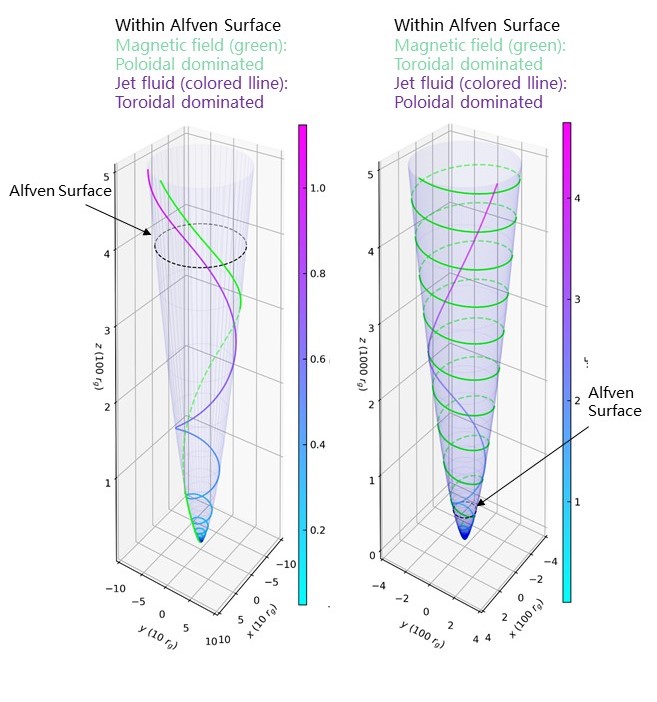The “Lightsaber” Explained: An Analytical Model of Astrophysical Jet is Built
Jets are ubiquitously in association with different celestial objects. The jet fluid forms a narrow beam and ejects itself from a "small" celestial space, just like a "lightsaber" breaks into the deep universe. The longest jet can reach a range 10 billion times longer than its initial radius, and the maximum jet velocity can reach up to 99.99% of the speed of light. The process of how jet launching, acceleration and collimation is one of the main unsolved problems in astrophysics.
Recently, a study led by Professor Liang Chen from Shanghai Astronomical Observatory of the Chinese Academy of Sciences has built an analytical model regarding magnetically dominated astrophysical jet, which quantitatively resolves all the jet properties, and consequently depicts the process of jet launching, acceleration and collimation. The result was recently published in The Astrophysical Journal with title: “Analytical Solution of Magnetically Dominated Astrophysical Jets and Winds: Jet Launching, Acceleration, and Collimation”.
Although the jet phenomenon has been discovered for more than 100 years, extensive studies on jets began merely more than 50 years ago getting benefit from an unprecedented development of radio telescope. It is generally believed that the magnetic field plays an important role in the jet process. The radial dynamic equilibrium of a magnetically dominated jet is controlled by the so-called "pulsar" equation (force-free condition applies). This equation, established in 1960s, is not easy to be solved even by numerical method since it is highly nonlinear and has a singularity.
Undoubtedly, the rapid development of numerical simulation has significantly improved our understanding of the jet physics. However, the “complexity” of numerical simulation makes it harder to quantitatively duplicate accumulated observations.
Inspired by the numerical simulation, the researchers separate the “pulsar” equation into rotating and non-rotating terms, and find that each of the two-term equations can be solved analytically, and the two solutions match each other very well.
Based on this general approximate solution, an analytical jet model is built, which quantitatively measures all properties of a magnetically dominated jet. Therefore, the process of jet launching, acceleration and collimation can be described. For example, the model analytically measures the jet acceleration from non-relativistic to relativistic.
Qualitatively, the magnetic field behaves like a rigid wire, and the plasma fluid can hardly move across the magnetic field lines (frozen) and it behaves like beads slide freely along the direction of magnetic field lines.
At the beginning of jet formation, the celestial object drags the magnetic field lines rotating, which can “throw out” the frozen plasma by centrifugal force. At this stage, the magnetic field is poloidal dominated, and jet fluid motion is toroidal dominated.
As the jet propagates outward, the magnetic field gets weak, and the magnetic pressure gradient force will accelerate the jet fluid. As the magnetic field energy is gradually transformed into the jet kinetic energy, the magnetic field lines will be twisted. After crossing a characteristic surface known as “Alfven surface”, the twisted magnetic field becomes toroidal dominated, and the jet fluid motion becomes poloidal dominated.
This analytical solution is consistent with known theoretical results and numerical simulations, and can be applied to interpret main observations of jet in active galactic nuclei, gamma-ray bursts and pulsars, such as jet configuration, acceleration, polarization, stratification, periodical variability, etc. The model also predicts more abundant phenomena, waiting for future observational tests. This solution helps to understand and validate simulations as well.

Figure. The jet launched from a black hole with a spin a=0.1, where the green line represents the magnetic field line and the colored line represents the trajectory of the jet fluid with different colors indicating different velocities (purple corresponds higher velocity).
Link to the Scientific Work:
https://iopscience.iop.org/article/10.3847/1538-4357/abc42d
Science Contact: CHEN Liang, Shanghai Astronomical Observatory, Chinese Academy of Sciences, chenliang@shao.ac.cn
News Contact: ZUO Wenwen, Shanghai Astronomical Observatory, Chinese Academy of Sciences, wenwenzuo@shao.ac.cn, 021-34775125
Download attachments: